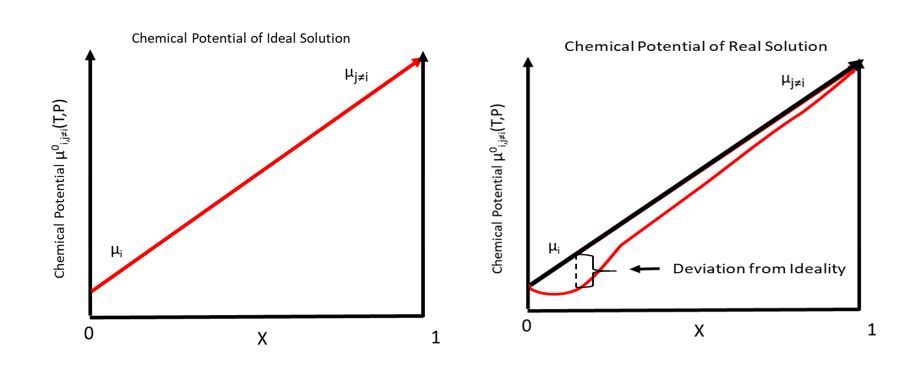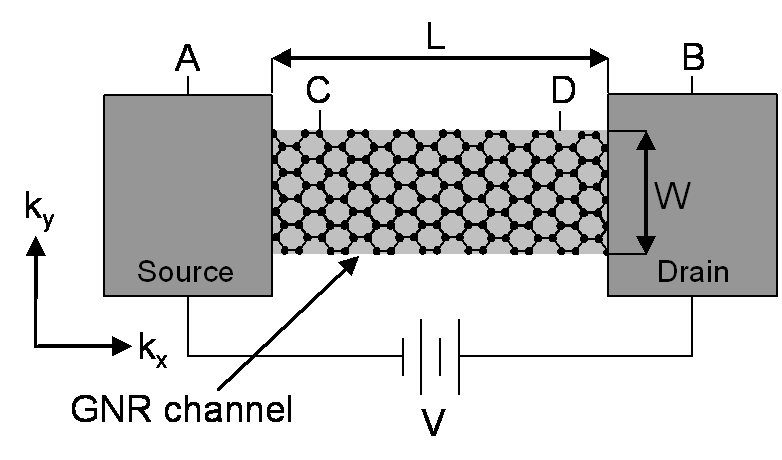|
Landauer Formula
The Landauer formula—named after Rolf Landauer, who first suggested its prototype in 1957—is a formula relating the electrical resistance of a quantum conductor to the scattering properties of the conductor. In the simplest case where the system only has two terminals, and the scattering matrix of the conductor does not depend on energy, the formula reads : G(\mu) = G_0 \sum_n T_n (\mu) \ , where G is the electrical conductance, G_0 = e^2/(\pi\hbar) \approx 7.75\times 10^ \Omega^ is the conductance quantum, T_n are the transmission eigenvalues of the channels, and the sum runs over all transport channels in the conductor. This formula is very simple and physically sensible: The conductance of a nanoscale conductor is given by the sum of all the transmission possibilities that an electron has when propagating with an energy equal to the chemical potential, E=\mu . A generalization of the Landauer formula for multiple probes is the Landauer–Büttiker formula, proposed by L ... [...More Info...] [...Related Items...] OR: [Wikipedia] [Google] [Baidu] |
Rolf Landauer
Rolf William Landauer (February 4, 1927 – April 27, 1999) was a German-American physicist who made important contributions in diverse areas of the thermodynamics of information processing, condensed matter physics, and the conductivity of disordered media. In 1961 he discovered Landauer's principle, that in any logically irreversible operation that manipulates information, such as erasing a bit of memory, entropy increases and an associated amount of energy is dissipated as heat. This principle is relevant to reversible computing, quantum information and quantum computing. He also is responsible for the Landauer formula relating the electrical resistance of a conductor to its scattering properties. He won the Stuart Ballantine Medal of the Franklin Institute, the Oliver Buckley Prize of the American Physical Society and the IEEE Edison Medal, among many other honors. Biography Landauer was born on February 4, 1927, in Stuttgart, Germany. He emigrated to the United States ... [...More Info...] [...Related Items...] OR: [Wikipedia] [Google] [Baidu] |
Electrical Resistance And Conductance
The electrical resistance of an object is a measure of its opposition to the flow of electric current. Its reciprocal quantity is , measuring the ease with which an electric current passes. Electrical resistance shares some conceptual parallels with mechanical friction. The SI unit of electrical resistance is the ohm (), while electrical conductance is measured in siemens (S) (formerly called the 'mho' and then represented by ). The resistance of an object depends in large part on the material it is made of. Objects made of electrical insulators like rubber tend to have very high resistance and low conductance, while objects made of electrical conductors like metals tend to have very low resistance and high conductance. This relationship is quantified by resistivity or conductivity. The nature of a material is not the only factor in resistance and conductance, however; it also depends on the size and shape of an object because these properties are extensive rather than i ... [...More Info...] [...Related Items...] OR: [Wikipedia] [Google] [Baidu] |
S-matrix
In physics, the ''S''-matrix or scattering matrix relates the initial state and the final state of a physical system undergoing a scattering process. It is used in quantum mechanics, scattering theory and quantum field theory (QFT). More formally, in the context of QFT, the ''S''-matrix is defined as the unitary matrix connecting sets of asymptotically free particle states (the ''in-states'' and the ''out-states'') in the Hilbert space of physical states. A multi-particle state is said to be ''free'' (non-interacting) if it transforms under Lorentz transformations as a tensor product, or ''direct product'' in physics parlance, of ''one-particle states'' as prescribed by equation below. ''Asymptotically free'' then means that the state has this appearance in either the distant past or the distant future. While the ''S''-matrix may be defined for any background (spacetime) that is asymptotically solvable and has no event horizons, it has a simple form in the case of the Minkow ... [...More Info...] [...Related Items...] OR: [Wikipedia] [Google] [Baidu] |
Conductance Quantum
The conductance quantum, denoted by the symbol , is the quantized unit of electrical conductance. It is defined by the elementary charge The elementary charge, usually denoted by is the electric charge carried by a single proton or, equivalently, the magnitude of the negative electric charge carried by a single electron, which has charge −1 . This elementary charge is a fundame ... ''e'' and Planck constant ''h'' as: :G_0 = \frac = It appears when measuring the conductance of a quantum point contact, and, more generally, is a key component of the Landauer formula, which relates the electrical conductance of a quantum conductor to its quantum properties. It is twice the reciprocal of the von Klitzing constant (2/''R''K). Note that the conductance quantum does not mean that the conductance of any system must be an integer multiple of ''G''0. Instead, it describes the conductance of two quantum channels (one channel for spin up and one channel for spin down) if the proba ... [...More Info...] [...Related Items...] OR: [Wikipedia] [Google] [Baidu] |
Transmission Coefficient
The transmission coefficient is used in physics and electrical engineering when wave propagation in a medium containing discontinuities is considered. A transmission coefficient describes the amplitude, intensity, or total power of a transmitted wave relative to an incident wave. Overview Different fields of application have different definitions for the term. All the meanings are very similar in concept: In chemistry, the ''transmission coefficient'' refers to a chemical reaction overcoming a potential barrier; in optics and telecommunications it is the amplitude of a wave transmitted through a medium or conductor to that of the incident wave; in quantum mechanics it is used to describe the behavior of waves incident on a barrier, in a way similar to optics and telecommunications. Although conceptually the same, the details in each field differ, and in some cases the terms are not an exact analogy. Chemistry In chemistry, in particular in transition state theory, there a ... [...More Info...] [...Related Items...] OR: [Wikipedia] [Google] [Baidu] |
Chemical Potential
In thermodynamics, the chemical potential of a species is the energy that can be absorbed or released due to a change of the particle number of the given species, e.g. in a chemical reaction or phase transition. The chemical potential of a species in a mixture is defined as the rate of change of free energy of a thermodynamic system with respect to the change in the number of atoms or molecules of the species that are added to the system. Thus, it is the partial derivative of the free energy with respect to the amount of the species, all other species' concentrations in the mixture remaining constant. When both temperature and pressure are held constant, and the number of particles is expressed in moles, the chemical potential is the partial molar Gibbs free energy. At chemical equilibrium or in phase equilibrium, the total sum of the product of chemical potentials and stoichiometric coefficients is zero, as the free energy is at a minimum. In a system in diffusion equilibrium, ... [...More Info...] [...Related Items...] OR: [Wikipedia] [Google] [Baidu] |
Ballistic Conduction
In mesoscopic physics, ballistic conduction (ballistic transport) is the unimpeded flow (or transport) of charge carriers (usually electrons), or energy-carrying particles, over relatively long distances in a material. In general, the resistivity of a material exists because an electron, while moving inside a medium, is scattered by impurities, defects, thermal fluctuations of ions in a crystalline solid, or, generally, by any freely-moving atom/molecule composing a gas or liquid. Without scattering, electrons simply obey Newton's second law of motion at non-relativistic speeds. The mean free path of a particle can be described as the average length that the particle can travel freely, i.e., before a collision, which could change its momentum. The mean free path can be increased by reducing the number of impurities in a crystal or by lowering its temperature. Ballistic transport is observed when the mean free path of the particle is (much) longer than the dimension of the med ... [...More Info...] [...Related Items...] OR: [Wikipedia] [Google] [Baidu] |
Mesoscopic Physics
Mesoscopic physics is a subdiscipline of condensed matter physics that deals with materials of an intermediate size. These materials range in size between the nanoscale for a quantity of atoms (such as a molecule) and of materials measuring micrometres. The lower limit can also be defined as being the size of individual atoms. At the micrometre level are bulk materials. Both mesoscopic and macroscopic objects contain many atoms. Whereas average properties derived from constituent materials describe macroscopic objects, as they usually obey the laws of classical mechanics, a mesoscopic object, by contrast, is affected by thermal fluctuations around the average, and its electronic behavior may require modeling at the level of quantum mechanics.Sci-Tech Dictionary. McGraw-Hill Dictionary of Scientific and Technical Terms. 2003. McGraw-Hill Companies, Inc A macroscopic electronic device, when scaled down to a meso-size, starts revealing quantum mechanical properties. For example, at ... [...More Info...] [...Related Items...] OR: [Wikipedia] [Google] [Baidu] |
Quantum Mechanics
Quantum mechanics is a fundamental theory in physics that provides a description of the physical properties of nature at the scale of atoms and subatomic particles. It is the foundation of all quantum physics including quantum chemistry, quantum field theory, quantum technology, and quantum information science. Classical physics, the collection of theories that existed before the advent of quantum mechanics, describes many aspects of nature at an ordinary ( macroscopic) scale, but is not sufficient for describing them at small (atomic and subatomic) scales. Most theories in classical physics can be derived from quantum mechanics as an approximation valid at large (macroscopic) scale. Quantum mechanics differs from classical physics in that energy, momentum, angular momentum, and other quantities of a bound system are restricted to discrete values ( quantization); objects have characteristics of both particles and waves (wave–particle duality); and there are limit ... [...More Info...] [...Related Items...] OR: [Wikipedia] [Google] [Baidu] |



